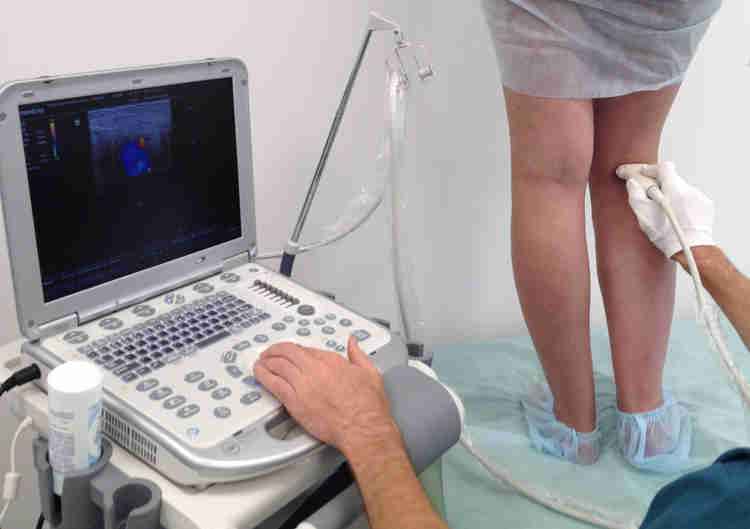What Is a Leg Arterial Ultrasound?
An ultrasound is a type of diagnostic imaging procedure that uses high frequency sound waves to create an image of the interior of the body. Ultrasounds are particularly effective for creating crisp, clean images that can be used to diagnose issues with soft tissue, such as arteries.
A leg arterial ultrasound is used to pinpoint the cause of issues that are suspected to originate in the arteries of the leg. Each leg contains a number of large arteries, the biggest of which is the femoral artery. With a ultrasound, a doctor can determine whether there is a blockage or damage.

Leg ultrasound is usually performed in standing position
Why Would You Need a Leg Arterial Ultrasound?
A leg arterial ultrasound is most typically performed when a doctor suspects that blood flow in a leg artery has been impeded. This presents with a wide variety of different symptoms, although pain that prevents ordinary use of the affected leg is a universal element.
A leg arterial ultrasound can be performed on patients of any age or background. In general, most of the conditions that may make the procedure necessary become more likely with age. However, an accident or injury might make a ultrasound a requirement of treatment at any time.
What is the Leg Arterial Ultrasound Procedure?
A ultrasound is a risk-free procedure that does not use radiation. Depending on the area to be imaged, it may require the application of blood pressure cuffs around various parts of the limb. These help make it easier to measure the difference in blood flow in different areas.
A specialized water soluble gel is applied to the area to be imaged. Then, an imaging wand called a transducer is waved back and forth over the leg to capture the images. There is no pain or discomfort associated with the imaging itself.
The whole process generally takes only a few minutes. The ultrasound delivers black and white images of the leg, the artery of concern, and the surrounding area. Using these, your medical team can choose the best way to treat the artery.
What Are Symptoms Indicating You May Need a Leg Arterial Ultrasound?
When your veins have trouble sending blood from your limbs back to the heart, it’s known as venous insufficiency. In this condition, blood doesn’t flow back properly to the heart, causing blood to pool in the veins in your legs.
Several factors can cause venous insufficiency, though it’s most commonly caused by blood clots (deep vein thrombosis) and varicose veins.
A leg arterial ultrasound is most commonly required when a patient reports symptoms of a burning, throbbing ache, typically confined to one leg, may indicate a problem.
A blood clot can occur virtually anywhere in the body, but the arteries of the legs are at significant risk, particularly if the patient has risk factors like obesity or specific health conditions. Using a leg arterial ultrasound, the doctor can discover the exact location where blood flow is impeded by a clot or reflux.
Other issues can prompt a leg arterial ultrasound, such as trauma to the leg where arterial damage must be diagnosed before treatment can be applied. Whatever the case, a leg arterial ultrasound helps ensure that the treatment matches the specific situation to be cared for.
Treatment options for leg veins
The treatment that follows a leg arterial ultrasound depends upon the problem discovered in the imaging process. In general, blood clots can be treated through the use of medication, including blood thinners. In some cases, surgery may be necessary.
An accurate leg arterial ultrasound is an important first step in a course of treatment for a serious leg vein issue. It’s important that it be performed under the leadership of an experienced physician who understands how to collect and interpret ultrasound data effectively.
With the right expertise, a leg arterial ultrasound is convenient and effective.
To learn more or schedule an appointment visit: Advance Heart and Vein Center
